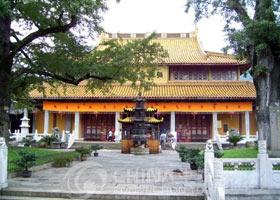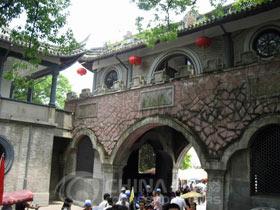 Located in the Xuedou Mountain Scenic Site of Xikou in Fenghua, the Xuedou Temple, one of the Ten Great Chanzong Temples in Southern Song Dynasty, has a long history of over 1,600 years. Being the rite of Monk Maitrdya, it attracts a large number of eminent monks and pilgrims. In 1994, Zhao Puchu, the president of the Buddhism Association of China granted the Xuedou Temple as one the Five Famous Buddhism Mountains.
Located in the Xuedou Mountain Scenic Site of Xikou in Fenghua, the Xuedou Temple, one of the Ten Great Chanzong Temples in Southern Song Dynasty, has a long history of over 1,600 years. Being the rite of Monk Maitrdya, it attracts a large number of eminent monks and pilgrims. In 1994, Zhao Puchu, the president of the Buddhism Association of China granted the Xuedou Temple as one the Five Famous Buddhism Mountains.
Xuedou Temple is near the Qianzhangya Waterfalls and in the valley of Xuedou Mountain. The Temple, so to speak, is "Embraced by green mountains on all four sides and girded by singing springs all round". According to the Annals of Xuedou Temple compiled in the Qing Dynasty, Xuedou Temple was first built in the Jin Dynasty (265-420) and relocated at the present site in the Tang (841), and for a time it was known as "Pubu Guanyin Temple" or literally "Bodhisattva Temple near Waterfalls.
" The temple was the favorite of several generations of emperors of the Song Dynasty, who issued successively some 40 imperial edicts to the temple to its great honor. In 999 in the Northern Song Dynasty, Emperor Zhao Heng named it "Xuedou Holy Temple". Story has it that in 1037, Emperor Ren Zong of the Song once had a dream in which he was touring Xuedou Temple and thanks to his dream, the temple was named "the Temple in the Dream".
Since then the mountain has known as one of the five most famous mountains and the temple one of The Ten most famous temples of China. Since its establishment, the temple has undergone several destructions and reconstructions. In 1651 AD, for example, Monk Shiqi took the lead to rebuild the temple. In 1953 and 1962, the Chinese government allocated special funds for the thorough repairs of the buildings and for the decoration of the Buddha figures.
In 1986, thanks to the donations from various social communities, the temple was rebuilt once more. The temple at present covers a construction area of over 20,000 sq meters and the total area of the temple is some 8.7 hectares.
 In its long history, Xuedou Temple has enjoyed high reputation in the Buddhism world home and abroad, being a place where large numbers of eminent masters from various Buddhist sects practiced Buddhism. According to the Historical Archive of Xuedou Temple, the Temple has had the honor to be in the charge of five masters from the Fayan Sect, nine from the Yumen Sect, eight from the Caodong Sect, nineteen from the Linji Sect, and some more whose sects are now unknown. A very eminent one of these masters is Master Zhijue of the Later Zhou Dynasty (951-960), the third successor of the Fayan Sect, who is the author of the famous Buddhist masterpiece "Zong Jing Lu". Of the abbots of Xuedou Temple, Master Zhijian of the Southern Dynasty (1190-1194), the 12th Master of the Caodong Sect, was teacher of Master Rujing of Tiantong Temple and Master Rujing was in turn teacher of Master Daoyuan, the founder of the Caodong Sect of Japan. That is why the disciples of the Caodong Sect in Japan take Xuedou Temple as their holy temple. In 1930's, Master Taixu, then Head of Buddhism Association of China, was abbot of Xuedou Temple, at the invitation of Chiang Kai-shek.
In its long history, Xuedou Temple has enjoyed high reputation in the Buddhism world home and abroad, being a place where large numbers of eminent masters from various Buddhist sects practiced Buddhism. According to the Historical Archive of Xuedou Temple, the Temple has had the honor to be in the charge of five masters from the Fayan Sect, nine from the Yumen Sect, eight from the Caodong Sect, nineteen from the Linji Sect, and some more whose sects are now unknown. A very eminent one of these masters is Master Zhijue of the Later Zhou Dynasty (951-960), the third successor of the Fayan Sect, who is the author of the famous Buddhist masterpiece "Zong Jing Lu". Of the abbots of Xuedou Temple, Master Zhijian of the Southern Dynasty (1190-1194), the 12th Master of the Caodong Sect, was teacher of Master Rujing of Tiantong Temple and Master Rujing was in turn teacher of Master Daoyuan, the founder of the Caodong Sect of Japan. That is why the disciples of the Caodong Sect in Japan take Xuedou Temple as their holy temple. In 1930's, Master Taixu, then Head of Buddhism Association of China, was abbot of Xuedou Temple, at the invitation of Chiang Kai-shek.
